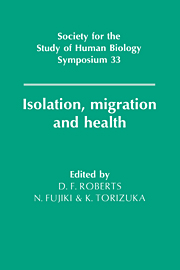Book contents
- Frontmatter
- Contents
- List of contributors
- Preface
- 1 The legacy of the IBP: Presidential Address
- 2 The distinction between primary and secondary isolates
- 3 Time trends in the break-up of isolates
- 4 Factors influencing the frequency of consanguineous marriages in Japan
- 5 Break-up of isolates
- 6 Isolates in India: their origin and characterisation
- 7 Consanguineous marriages and their genetical consequences in some Indian populations
- 8 Biomedical and immunogenetic variation in isolated populations in India
- 9 Genetic distance analyses in Israeli groups using classical markers and DNA polymorphisms in the β globin gene
- 10 Non-random distribution of Gm haplotypes in northern Siberia
- 11 Allele frequency estimation
- 12 Genetic affinities of human populations
- 13 Inherited neurological diseases in island isolates in southern Japan
- 14 Serological and virological evidence for human T-lymphotropic virus type I infection among the isolated Hagahai of Papua New Guinea
- 15 Analysis of genes associated with hypercholesterolaemia in the Japanese population
- 16 Migrant studies and their problems
- 17 Tokelau: migration and health in a small Polynesian society - a longitudinal study
- 18 Micromigrations of isolated Tuareg tribes of the Sahara Desert
- 19 Population structure in the eastern Adriatic: the influence of historical processes, migration patterns, isolation and ecological pressures, and their interaction
- 20 Diabetes and diabetic macroangiopathy in Japanese-Americans
- 21 Diabetes and westernisation in Japanese migrants
- 22 Environmental factors affecting ischemic heart disease
- Epilogue
- Index
9 - Genetic distance analyses in Israeli groups using classical markers and DNA polymorphisms in the β globin gene
Published online by Cambridge University Press: 05 March 2012
- Frontmatter
- Contents
- List of contributors
- Preface
- 1 The legacy of the IBP: Presidential Address
- 2 The distinction between primary and secondary isolates
- 3 Time trends in the break-up of isolates
- 4 Factors influencing the frequency of consanguineous marriages in Japan
- 5 Break-up of isolates
- 6 Isolates in India: their origin and characterisation
- 7 Consanguineous marriages and their genetical consequences in some Indian populations
- 8 Biomedical and immunogenetic variation in isolated populations in India
- 9 Genetic distance analyses in Israeli groups using classical markers and DNA polymorphisms in the β globin gene
- 10 Non-random distribution of Gm haplotypes in northern Siberia
- 11 Allele frequency estimation
- 12 Genetic affinities of human populations
- 13 Inherited neurological diseases in island isolates in southern Japan
- 14 Serological and virological evidence for human T-lymphotropic virus type I infection among the isolated Hagahai of Papua New Guinea
- 15 Analysis of genes associated with hypercholesterolaemia in the Japanese population
- 16 Migrant studies and their problems
- 17 Tokelau: migration and health in a small Polynesian society - a longitudinal study
- 18 Micromigrations of isolated Tuareg tribes of the Sahara Desert
- 19 Population structure in the eastern Adriatic: the influence of historical processes, migration patterns, isolation and ecological pressures, and their interaction
- 20 Diabetes and diabetic macroangiopathy in Japanese-Americans
- 21 Diabetes and westernisation in Japanese migrants
- 22 Environmental factors affecting ischemic heart disease
- Epilogue
- Index
Summary
Introduction
The massive immigration of over a million Jews from all parts of the world into Israel during the last 60 years that is still continuing today (Figure 9.1) provided an opportunity for genetic anthropological studies of the diverse ingathering groups. These led to an appreciation of how heterogeneous is each of these communities, and how much they differ genetically from each other and their previous host populations (Goldschmidt, 1963; Ramot et al., 1973; Bonné-Tamir et al., 1978, 1979). In these studies over the last 28 years various genetic polymorphisms, including red cell and leucocyte (HLA) antigens, serum protein groups and red cell enzyme systems, were used to construct the genetic profiles of each community.
While many studies recognised some degree of affinity between the major Jewish populations (Bonné-Tamir et al., 1979; Karlin et al., 1979; Kobylianksy et al., 1982), the amount of admixture between them and their neighbours remained controversial. Discrepancies in results are due in part to the use of different loci; for example up to 100% admixture of Ashkenazim with other East European peoples was estimated when using the ABO alleles but 0% admixture when the HLA alleles were utilised (Cavalli-Sforza & Carmelli, 1979; Motulsky, 1980). Different methods in deriving admixture rates also yielded contradictory results (Morton et al., 1982; Wijsman, 1984).
A new era in the study of genetic variation began in the 1980s when methods were developed to study polymorphisms directly in the DNA molecules (Botstein et al., 1980).
- Type
- Chapter
- Information
- Isolation, Migration and Health , pp. 87 - 106Publisher: Cambridge University PressPrint publication year: 1992



